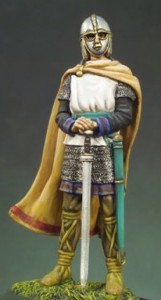- Stay Connected
 Abraham Lincoln
If given the truth, the people can be depended upon to meet any national crisis...
Abraham Lincoln
If given the truth, the people can be depended upon to meet any national crisis...
 Guildford news...
for Guildford people, brought to you by Guildford reporters - Guildford's own news service
Guildford news...
for Guildford people, brought to you by Guildford reporters - Guildford's own news service
A Statue for Guildford – Why Not A Saxon Warrior?
Published on: 26 Mar, 2012
Updated on: 27 Mar, 2012
From A Local Historian (Name and address supplied)
 There is currently a proposal to put a statue commemorating the Guildford Guy riots of the 1860s on the Woodbridge Road roundabout. Is this really a good idea?
There is currently a proposal to put a statue commemorating the Guildford Guy riots of the 1860s on the Woodbridge Road roundabout. Is this really a good idea?
The riots were lawless occasions which were great fun for those involved, but left a lot of people in fear. If they were happening today, would we approve of them? History casts a warm glow over the past so that, for example, we chuckle over Charles II’s mistresses but get more censorious over modern royal infidelities.
The Guy riots were not a good cause and they have had no effect on the history of Guildford, except as something to entertain us. There are other subjects or events much more worthy of being remembered.
The riots are interesting in that they show the dead hand of Victorian respectability crushing a popular custom, though apparently some of those involved were from ‘respectable’ homes. Shrove Tuesday football in Surrey towns was similarly crushed in the later 19th century, and fairs such as St. Catherine’s were ended.
Morris dancing and folk singing were dying out, only to be revived within a generation by the same sort of people who had crushed the more exuberant popular customs. Gertrude Jekyll saw the material culture of the country people vanishing, and collected it, and others like Lucy Broadwood, Vaughan Williams and Cecil Sharp collected the songs and dances.
They were, however, a shadow of the originals. Songs were tidied up and refined, children were taught to dance and even women did Morris dancing, which was never part of the southern tradition. The Provençal ‘maypole’ with ribbon-plaiting was introduced to schools, a totally different thing from the enormous, permanent, poles around which men and women danced (without ribbons) in the past.
One pole survives at Wood Street, and a modern version was introduced to Guildford for May Day by Matthew Alexander in 1975, and is still used. This collecting was a very good thing because it preserved the beautiful tunes and words of folk music, even if it was no longer in its original context.
The Guy riots were certainly part of an authentic popular movement, which continues with less risk to life and limb in the Sussex towns around Lewes. Would it not be better to celebrate events or people which have had a lasting effect on Guildford?
For example, why not have a statue of a Saxon warrior? Guildford was founded by the Anglo-Saxons in the 5th century, as part of the migration from northern Europe. Most early Saxon settlements in Surrey were near London, and Guildford is out on a limb. Was it an early settlement moving westwards? We may not want to commemorate the violence which accompanied some of the Saxon invasions, but a statue of a Saxon would remind us of our origins. Without the Saxons, we would not be living in Guildford.
Another possibility is something to do with the wool trade, Guildford was a wool town for hundreds of years, but there is little left to remind us, apart from the woolpack on the Borough arms. A woolpack might look a bit dull. Sheep would be better but we already have some, albeit on private property at Eastgate Court.
What about a reminder of the cattle market, a vital part of Guildford’s life for centuries? It was moved to Woodbridge Road, near the roundabout, in 1896. A farm animal might bring a pleasant rural touch to this area. Or we could have a farmer with a sack of grain, since the Cornmarket was equally important.
Cricket has both modern and ancient links. It was in Guildford that the first written reference to cricket was made. An enquiry was being held about a piece of land in North Street which had been waste land belonging to the borough, but had been taken over by a carpenter.
Several old people gave evidence that in their childhood in the 1540s it had been open land and as schoolboys they had played cricket there. (They also went to bear-baitings there but we will pass over that.) Woodbridge Road, of course, runs past the modern cricket ground, and an earlier ground was even closer to the roundabout.
Then there is Lewis Carroll, who as Charles Dodgson found a home here for his sisters, and for himself in university vacations. We already have statues about Alice, but why not the man himself? He did a lot more than write the Alice books, and he made a life for himself in Guildford.
Finally there is one man who made a tremendous difference to Guildford, introducing amenities we now take for granted, and building some fine houses, shops and public buildings in the town. I refer to Henry Peak, who crowned a distinguished career by becoming mayor of Guildford.
There are doubtless other worthy subjects for a statue, but all these were important to the town and have had a long-lasting effect on it.














Gordon Bridger
March 27, 2012 at 6:54 pm
I am obviously not the only one who thinks it is absurd to have a statue to commemorate the Guy Riots especially one made of strange bits of iron which no one will have the slightest idea what it is supposed to represent.
Instead of looking to the past why not celebrate something Guildford is famous for now, a satellite for instance? Prof. Sweeting of Surrey Space Technology might give his support. It would be a real credit to them and Guildford.